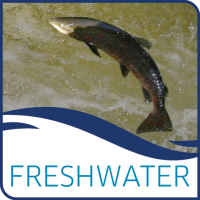Sampling of individual adult salmon is used to collect information on the size, sex and age of the fish. This information feeds directly into the stock assessments used for national and international management of Scottish salmon. Sampling of individuals can also provide information on their condition, while examination of scale samples allows their growth history to be investigated.
In Scotland, and other countries, scale samples were historically collected from commercial netting but most of these fisheries have closed in recent years. Due to a lack of sampling information, it has been assumed that there have been no changes in age or size of salmon returning to Scotland since 2018. This is clearly unrealistic given previously documented long-term shifts in the size and demography of salmon in Scotland. To fill this data gap the options for using existing rod fisheries and targeted scientific sampling as a source of biological information on returning adult salmon were investigated.
Please note Additional sampling records have been added to the dataset since the release of the report. No previously published data has been changed, but data has been added for the most recent sampling year.
Data and Resources
- National Adult Salmon Sampling Project - Sampling recordscsv
The resource is structured with the following columns:
Preview Download
... - Report: National Adult Salmon Sampling Projecthtml
Access the report on the Scottish Government publications
Go to resource
| Field | Value |
|---|---|
| Publisher | |
| Modified | 2025-11-24 |
| Release Date | 2024-12-05 |
| Identifier | 1513144b-3c0b-40dd-96aa-67c403e2baef |
| Spatial / Geographical Coverage Area | POLYGON ((-7.3828125 54.509522450288, -7.3828125 58.757873846637, -0.9228515625 58.757873846637, -0.9228515625 54.509522450288)) |
| Temporal Coverage | 2021-05-01 to 2023-10-04 |
| Language | English (United Kingdom) |
| License | UK Open Government Licence (OGL) |
| Data Dictionary | During 2021-2023, a national adult salmon sampling programme was developed by the Marine Directorate, Fisheries Management Scotland and local District Salmon Fishery Boards and Trusts. The objectives of the programme were: To trial different approaches on obtaining biological data on adult salmon (length, weight, age) and to see what approaches to obtaining samples worked in different settings To inform the design of any future adult sampling programme for use in stock assessments. To provide information on the size sex and age of adult salmon that could be used to inform future stock assessments. A standard operating procedure was developed detailing a set of agreed shared practices for the sampling. These were designed to allow maximum flexibility for local arrangements to be made regarding, for example, how fish would be Adult salmon were sampled during July-September 2021, June-September 2022 and June-October 2023, with some additional samples provided from May in all three years. Sampling effort was not uniform across the three years but was a function of available funding, with most effort occurring in 2022, followed by 2021 then 2023. Fish were The relatively small number of samples gathered from some areas precludes an in-depth investigation of differences in the ages and sizes of fish sampled in different rivers. The results were therefore aggregated to a regional level. Further levels of aggregation were used to explore within and between year patterns |
| Contact Name | Marine Directorate |
| Contact Email | |
| Public Access Level | Public |


